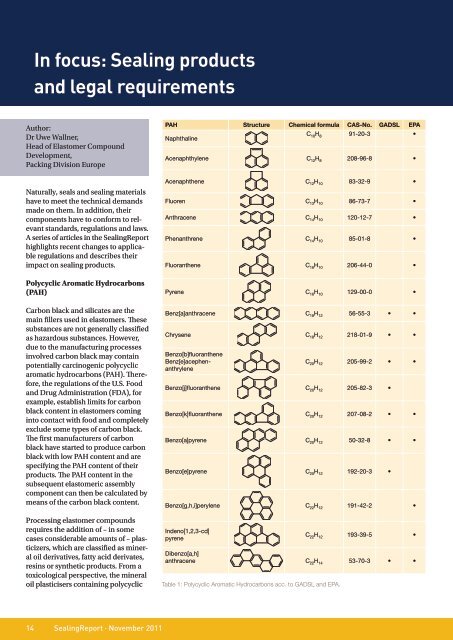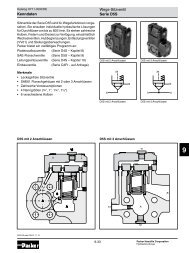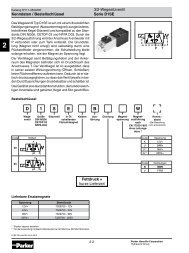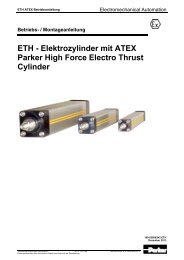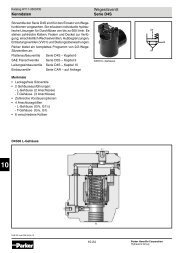Sealing products and legal requirements - Parker Hannifin ...
Sealing products and legal requirements - Parker Hannifin ...
Sealing products and legal requirements - Parker Hannifin ...
You also want an ePaper? Increase the reach of your titles
YUMPU automatically turns print PDFs into web optimized ePapers that Google loves.
In focus: <strong>Sealing</strong> <strong>products</strong><br />
<strong>and</strong> <strong>legal</strong> <strong>requirements</strong><br />
Author:<br />
Dr Uwe Wallner,<br />
Head of Elastomer Compound<br />
Development,<br />
Packing Division Europe<br />
Naturally, seals <strong>and</strong> sealing materials<br />
have to meet the technical dem<strong>and</strong>s<br />
made on them. In addition, their<br />
components have to conform to relevant<br />
st<strong>and</strong>ards, regulations <strong>and</strong> laws.<br />
A series of articles in the <strong>Sealing</strong>Report<br />
highlights recent changes to applicable<br />
regulations <strong>and</strong> describes their<br />
impact on sealing <strong>products</strong>.<br />
Polycyclic Aromatic Hydrocarbons<br />
(PAH)<br />
Carbon black <strong>and</strong> silicates are the<br />
main fillers used in elastomers. These<br />
substances are not generally classified<br />
as hazardous substances. However,<br />
due to the manufacturing processes<br />
involved carbon black may contain<br />
potentially carcinogenic polycyclic<br />
aromatic hydrocarbons (PAH). Therefore,<br />
the regulations of the U.S. Food<br />
<strong>and</strong> Drug Administration (FDA), for<br />
example, establish limits for carbon<br />
black content in elastomers coming<br />
into contact with food <strong>and</strong> completely<br />
exclude some types of carbon black.<br />
The first manufacturers of carbon<br />
black have started to produce carbon<br />
black with low PAH content <strong>and</strong> are<br />
specifying the PAH content of their<br />
<strong>products</strong>. The PAH content in the<br />
subsequent elastomeric assembly<br />
component can then be calculated by<br />
means of the carbon black content.<br />
Processing elastomer compounds<br />
requires the addition of – in some<br />
cases considerable amounts of – plasticizers,<br />
which are classified as mineral<br />
oil derivatives, fatty acid derivates,<br />
resins or synthetic <strong>products</strong>. From a<br />
toxicological perspective, the mineral<br />
oil plasticisers containing polycyclic<br />
14 <strong>Sealing</strong>Report · November 2011<br />
PAH Structure Chemical formula CAS-No. GADSL EPA<br />
Naphthaline<br />
C10H8 91-20-3 •<br />
Acenaphthylene C 12 H 8 208-96-8 •<br />
Acenaphthene C 12 H 10 83-32-9 •<br />
Fluoren C 13 H 10 86-73-7 •<br />
Anthracene C 14 H 10 120-12-7 •<br />
Phenanthrene C 14 H 10 85-01-8 •<br />
Fluoranthene C 16 H 10 206-44-0 •<br />
Pyrene C 16 H 10 129-00-0 •<br />
Benz[a]anthracene C 18 H 12 56-55-3 • •<br />
Chrysene C 18 H 12 218-01-9 • •<br />
Benzo[b]fluoranthene<br />
Benz[e]acephenanthrylene<br />
C 20 H 12 205-99-2 • •<br />
Benzo[j]fluoranthene C 20 H 12 205-82-3 •<br />
Benzo[k]fluoranthene C 20 H 12 207-08-2 • •<br />
Benzo[a]pyrene C 20 H 12 50-32-8 • •<br />
Benzo[e]pyrene C 20 H 12 192-20-3 •<br />
Benzo[g,h,i]perylene C 22 H 12 191-42-2 •<br />
Indeno[1,2,3-cd]<br />
pyrene<br />
C 22 H 12 193-39-5 •<br />
Dibenzo[a,h]<br />
anthracene C 22 H 14 53-70-3 • •<br />
Table 1: Polycyclic Aromatic Hydrocarbons acc. to GADSL <strong>and</strong> EPA.


